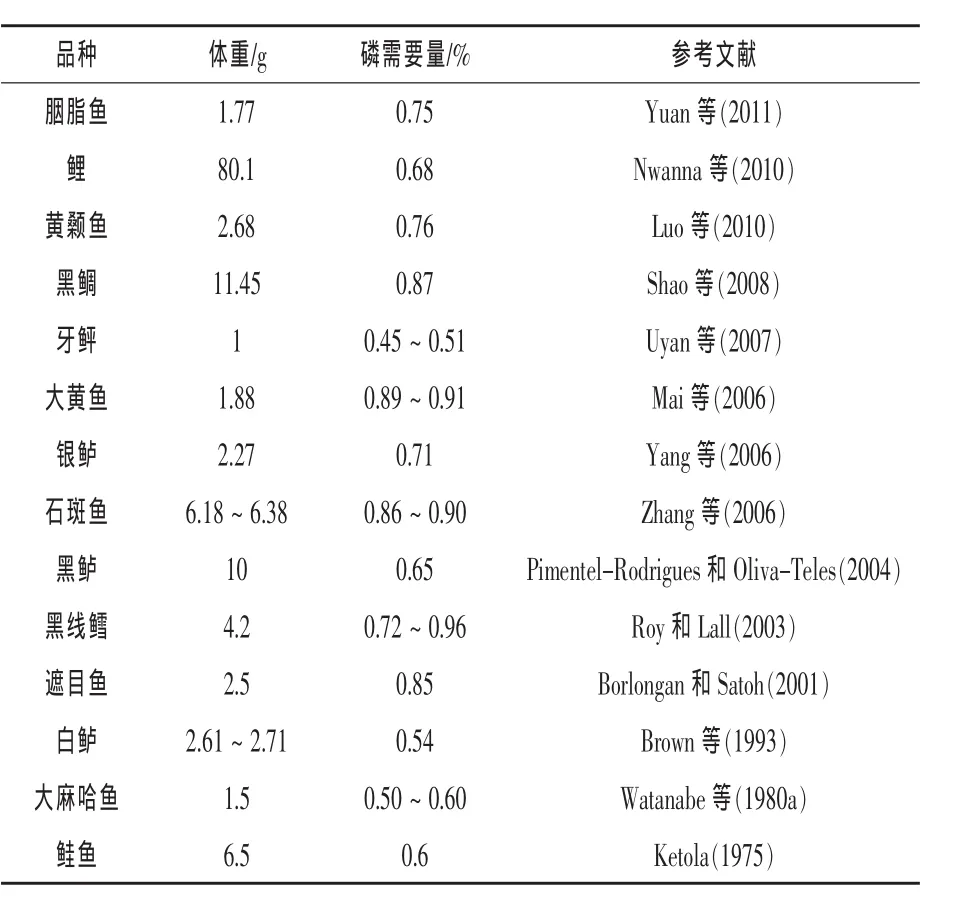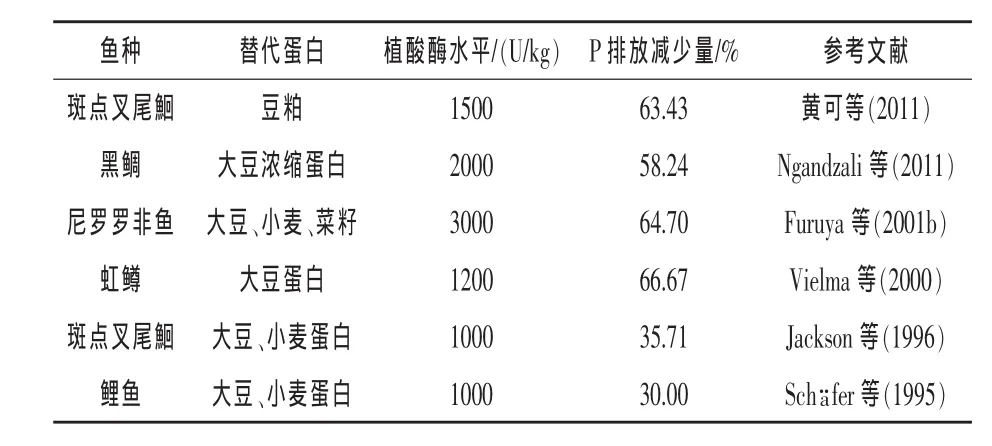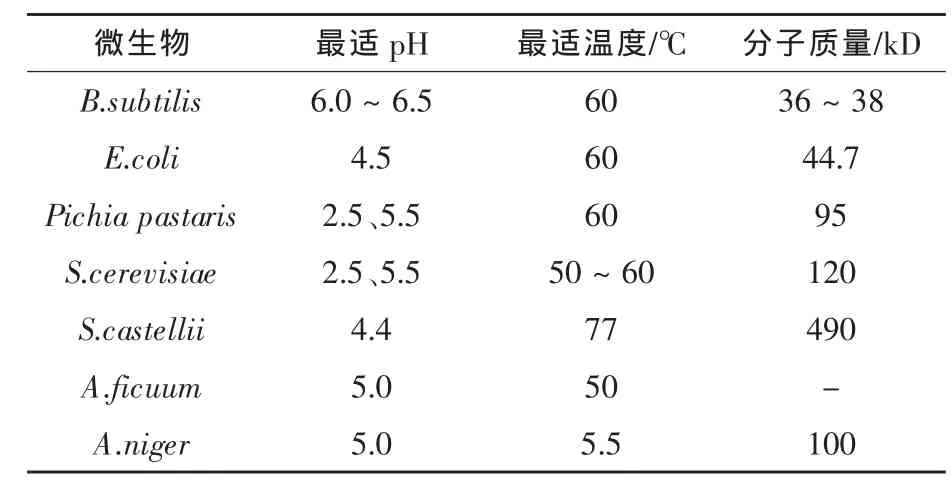水产动物对饲料中磷的利用研究进展
2013-10-19浙江大学动物科学学院邵庆均
浙江大学动物科学学院 陆 静 邵庆均
水产动物在养殖过程中氮、磷等元素过量排放引起的水体生态系统变化备受关注。减少养殖水体染已经成为保持世界水产养殖业可持续发展的一个重要方面。虽然氮、磷同为造成水体富营养化的主要元素,但藻类等水生生物对磷更为敏感。当水体中磷处于低浓度时,即使氮浓度能满足藻类等水生生物的需要,其生产力也会降低。因此,控制磷污染显得更为重要。据统计,生产1 t金头鲷或普通鲤鱼分别排放总磷13 kg左右(Watanabe 等,1999;Alvarado,1997)。因此从饲料方面来减少磷的排放是可推广的有效方法之一。本文就影响水产动物对饲料中磷利用的因素作一综述。
1 常见养殖鱼类对磷的需要量
磷是核酸和细胞膜的重要组成矿物质元素,也是骨组织的主要结构成分,且直接参与所有产生能量的胞内反应(NRC,1993)。鱼类能够在水中直接吸收磷元素,但水中磷浓度较低,远不能满足需要量,因此需要从饲料中摄取。而且,鱼类对钙的吸收受磷含量的影响,反之亦然,一般情况下鱼类适宜的钙磷比为1∶(1~2)。表1为常见养殖鱼类对磷的需要量。
由于影响鱼类磷需要的因素较多,不同研究者的试验方法不同,试验条件的差异等,结论各有不同。另外,研究者一般以体增重、血清磷含量、骨骼磷含量等为作为判定鱼类对磷需要量标准,因此,评价标准仍需进一步统一。

表1 常见养殖鱼类对磷的需要量
2 不同养殖鱼类对磷的消化率
鲤科(草鱼、鲤鱼等)、丽鱼科(罗非鱼等)和鲑科(大麻哈鱼、虹鳟、嘉鱼等)鱼类占世界水产养殖类的80%以上(FAO,2009)。大量文献显示,不同鱼类对磷的表观消化率相差很大。虹鳟对鱼粉中磷的利用率为17%~81%,罗非鱼为27%~65%;虹鳟对大豆粉中磷的利用率为20%~35%,而鲤鱼为33%,罗非鱼为35%~47%(Fu ruya 等 ,2001a;Mira.n.da 等 ,2000;Sugiura 和Hardy,2000;和, 2005)。 鱼类在消化系统解剖学和生理学上的差异,是磷在不同鱼种之间消化和吸收差异的重要原因。鲤科鱼类不能很好地消化低溶解度的磷化合物,对骨磷的消化率几乎为零,相比丽鱼科和鲑科鱼类磷酸氢钙盐的消化率 (62%~64%),鲤科鱼类只有30%(Hua和 Bureau,2010)。 存在这些差异的原因可能是鲤科鱼类为无胃鱼,因此缺乏一个利于磷化合物溶解的酸性环境。此外,鲤科和鲑科鱼类不能很好地利用植物成分中的植酸磷,而罗非鱼能较好地利用(Hua 和 Bureau,2010)。 Ellestad等(2002)在尼罗罗非鱼肠道内发现了较强活性的植酸酶,而在杂交条纹鲈鱼和鲤鱼中鲜现。而且,罗非鱼大肠中的微生物发酵过程产生的植酸酶或有机酸有助于其消化植酸磷。另外,鲤科鱼类的肠道结构简单且相对较短,减少了消化酶作用的时间及强度,从而影响磷的消化率。
3 水产动物对不同形式磷的利用率
3.1 不同来源 在配合饲料中,不同饲料原料的磷利用率存在明显差异。在常见动物性原料中,鱼粉和肉骨粉富含钙磷元素,是饲料总磷的主要来源(Halver和 Hardy,2002)。研究表明,以鱼粉为主要蛋白源的日粮含磷水平超过了维持鱼类良好生长的最低需求(Satoh等,2003)。但是,磷在鱼粉中的存在形式(磷酸三钙复合物)对有些养殖鱼类来说是很难被利用的,在生产过程中可以通过加工技术或化学方法处理来改变其存在形式,从而提高磷的利用率。在植物性原料中,磷以植酸盐的形式存在,这种存在形式的磷对大部分鱼来说利用率均较低。因此,磷利用率的变化在很大程度上是由磷的来源决定的(表2)。
为减少磷排放,在配制饲料时尽量使用可消化磷含量高的蛋白源。通常情况下,多种蛋白源混合的饲料在不影响鱼的生长性能的情况下具有较低的磷排泄水平。
3.2 不同化学形式 Riche和Brown(1996)研究发现,虹鳟对磷的有效利用率最大值出现在其对日粮磷最适需求量附近,Satoh等(1997)和Sugiura等(2000)也得到类似结果。因此,为使饲料磷水平正好或尽量接近该养殖鱼类生长的最佳需求,在生产过程中有时需要添加一定量的无机或有机磷化合物。磷的利用率与其溶解度有关,溶解度越高利用率越大(Pimentel-Rodrigues和Oliva-Teles,2007)。并且,不同磷源对添加水平变化的反应也是有差异的,Ca(H2PO4)2和 Ca3(PO4)2的表观消化率在低于需要水平的时候更高,而此时CaHPO4的消化率降低,引起这些结果的机制还尚待研究。

表2 鱼饲料中常见原料中磷的利用率
Niu等(2008)研究表明,添加 KH2PO4组南美白对虾的生长性能(增重量,特定生长率)和存活率显著优于添加 NaH2PO4或 Ca(H2PO4)2组。同样以南美白对虾为研究对象,Davis和Arnold(1994)测得无机磷源的利用率, 结果表明,Ca(H2PO4)2、CaHPO4、Ca3(PO4)2、KH2PO4和 NaH2PO4中磷的表观利用率分为46.13%、19.11%、9.19%、68.11%和68.12%。因此,KH2PO4可作为南美白对虾的最佳磷源 (最适总磷添加量为20.9~22.0 g/kg),原因可能跟渗透压和酸碱平衡有关。钠钾离子是海水动物的细胞外离子,虾类的细胞膜含有一个能量依赖性的钠泵,可以把钠离子从细胞内运输到细胞外环境中,因此需要更多的钾离子来平衡细胞内减少的钠离子,细胞外具有高浓度的钠离子,细胞内具有高浓度的钾离子。这样形成的钠钾离子浓度差激活ATP酶,利于海洋生物对环境的生理适应(Zhu 等,2004)。 Roy 等(2007)研究认为,日粮中钾含量的增加有助于提高水产动物的存活率。总体来说,水产动物对磷的生物利用率高低顺序为:KH2PO4> CaH2PO4> Ca(H2PO4)2或 CaHPO4> Ca3(PO4)2。
4 添加植酸酶对磷利用的影响
4.1 鱼粉替代蛋白 植物性原料部分替代鱼粉,在经济效益和低磷可持续水产饲料配方评估上均有很大的优势。植物原料中的植酸磷很难被鱼类应用,因此需要通过添加外源性植酸酶来提高饲料磷的利用率。例如,在大豆替代蛋白饲料中添加植酸酶可以改善胃肠道内植酸盐的水解作用,从而增加磷的消化和吸收率。不同鱼粉替代蛋白质添加植酸酶对磷排放的影响见表3。

表3 添加植酸酶对磷排放的影响
由表3可知,不同养殖种类的植酸酶适宜添加量不同,且即使同一养殖种类添加相同水平的植酸酶,在不同的饲料配方或养殖环境中,其减少磷排放的作用也有所差异。因此,要根据养殖种类、年龄、替代蛋白种类等因素调整添加水平,此外,还需要考虑到养殖系统、生产工艺等条件对植酸酶的影响。
4.2 不同来源的植酸酶 引起表3中结果差异的另一原因可能是添加的植酸酶来源的不同。植酸酶属于磷酸单酯水解酶,是磷酸酶的一种特殊类型。目前确认的植酸酶有两种类型,一种是存在于植物、酵母、霉菌和细菌中且需要Mg2+参与催化过程的3-磷酸水解酶(EC 3.1.3.8),这种植酸酶作用于植酸盐时,最先水解的是肌醇3号碳原子位置的磷酸根;另一种植酸酶为6-磷酸水解酶(EC 3.1.3.26),只存在于植物籽实中,其首先水解的是肌醇3号碳原子位置的磷酸根。动物胃肠道植酸酶一般有三种来源,分别来自饲料中动植物原料、微生物发酵产生和人工添加。
由于饲料原料来源的植酸酶活力较低,且在加工过程中的热处理会使其失活,而遗传工程技术的发展使产酶微生物能以适宜的成本生产足够浓度的酸性植酸酶,因此,目前商用植酸酶大多来源于微生物,而微生物中植酸酶种类繁多,性质各有差异(表 4)。
饲料生产过程中,根据养殖鱼类消化系统的不同生理条件,需要选择合适的植酸酶种类。同时,寻找一种常见养殖种类均能适用,即具有高耐热稳定性的中性植酸酶将是植酸酶研究工作中非常重要的一步。

表4 微生物植酸酶特性
4.3 植酸酶的不同添加方式 目前,植酸酶的添加方式有:直接混合添加;以包膜形式添加或制粒后喷雾添加;添加至经干燥处理的植物性原料中发酵预处理 (Cheng 和 Hardy,2003;Vielma 等,1998;Cain 和 Garling,1995)。 每种添加方式都有其优势和劣势,植酸酶的作用效果存在差异,但目前有关这方面的研究报道还较少。
陈京华和麦康森(2010)在5000.0 g豆粕中添加2.5 g植酸酶,然后用产朊假丝酵母(Candida utilis)进行发酵预处理。相比未添加植酸酶组和直接添加植酸酶组,植酸酶预处理豆粕组的磷排放率分别减少了 33.15%、9.36%。Denstadli等(2007)以大豆浓缩蛋白为基础饲料,比较了大西洋鲑对添加发酵预处理植酸酶和包膜植酸酶的差异,结果表明,发酵预处理组肠道的磷消化率显著高于包膜植酸酶组,表明植物性原料的发酵预处理能显著提高磷的消化率。
4.4 其他 维生素D最基本的功能是促进肠道钙磷的吸收,提高血液钙和磷水平,促进骨的钙化。在哺乳动物饲料中添加维生素D3能显著提高磷的消化率和吸收率,并能促进肾脏对磷的重吸收,从而减少磷的排放(Lee等,1986)。 Avila等(2000)在虹鳟肠道发现了与哺乳动物类似的钠依赖性磷运输机制。因此,大量研究者将维生素D3添加到水产动物饲料中,从磷代谢方面来控制磷的排放。Srivastav等(1997)研究报道,腹腔注射25-羟基维生素D3或1,25-二羟基维生素 D3均能提高淡水鲶鱼的血浆磷浓度,对虹鳟(Cheng和Hardy,2003)、 美国鳗鱼 (Fenwick 和Vermette,1989)也有类似报道。说明,低磷高维生素D3饲料能够通过调节磷代谢降低养殖污水可溶性磷和粪便磷水平。
另外,降低肠道pH能提高磷和植酸盐的溶解率,使之在肠道更好地被吸收。因此,可以通过补充有机酸来降低肠道pH,并能像螯合作用一样吸附肠道上的多种阳离子 (Ravindran和Kornegay,1993)。 Sarker等(2011)研究了在鱼粉及植物性原料为主的日粮中添加有机酸对黄鰤鱼仔鱼生长及氮磷利用的影响,结果表明,在饲料中添加有机酸(柠檬酸)后,鱼粉中的磷酸三钙盐能够在柠檬酸的作用下释放足够的磷以满足鱼类的生长需要,而无需再添加其他形式的无机磷。而且,鱼体灰分中磷含量增加的同时试验组具有更好的生长性能,说明添加有机酸能显著提高磷及其他元素的利用率。
[1]陈京华,麦康森.不同添加方式植酸酶处理豆粕对牙鲆生长和饲料利用率的影响[J].水生生物学报,2010,34(3):481 ~ 488.
[2]黄可,杨雨虹,刘行彪,等.植酸酶预处理饲料对斑点叉尾生长及磷利用率的影响[J].动物营养学报,2011,23(7):1217 ~ 1224.
[3]Alvarado J L.Aquafeeds and the environment[J].Feeding tomorrow’s fish,1997,275 ~ 289.
[4]Avila E M,Tu H,Basantes S,et al.Dietary phosphorus regulates intestinal transport and plasma concentrations of phosphate in rainbow trout[J].Journal of Comparative Physiology B:Biochemical,Systemic,and Environmental Physiology,2000,170(3):201 ~ 209.
[5]Borlongan I,Satoh S.Dietary phosphorus requirement of juvenile milkfish,Chanos chanos Forsskal[J].Aquaculture Research,2001,32:26 ~ 32.
[6]Brown M L,Jaramillo Jr F,Gatlin III D M.Dietary phosphorus requirement of juvenile sunshine bass,Morone chrysops♀ × M.saxatilis♂[J].Aquaculture,1993,113(4):355 ~ 363.
[7]Cain K D,Garling D L.Pretreatment of soybean meal with phytase for salmonid diets to reduce phosphorus concentrations in hatchery effluents[J].The Progressive Fish-Culturist,1995,57(2):114 ~ 119.
[8]Cheng Z J,Hardy R W.Effects of extrusion and expelling processing,and microbial phytase supplementation on apparent digestibility coefficients of nutrients in full-fat soybeans for rainbow trout (Oncorhynchus mykiss)[J].Aquaculture,2003,218(1 ~ 4):501 ~ 514.
[9]Davis D,Arnold C.Estimation of apparent phosphorus availability from inorganic phosphorus sources for Penaeus vannamei[J].Aquaculture,1994,127(2~ 3):245 ~ 254.
[10]Denstadli V,Storebakken T,Svihus B,et al.A comparison of online phytase pre-treatment of vegetable feed ingredients and phytase coating in diets for Atlantic salmon (Salmo salar L.)reared in cold water[J].Aquaculture,2007,269(1 ~ 4):414 ~ 426.
[11]Ellestad L,Angel R,Soares J.Intestinal phytase II:A comparison of activity and in vivo phytate hydrolysis in three teleost species with differing digestive strategies[J].Fish Physiology and Biochemistry,2002,26(3):259 ~ 273.
[12]FAO.The State of the World Fisheries and Aquaculture 2008[M].FAO Fisheries and Aquaculture Dept,2009.
[13]Fenwick J,Vermette M.Vitamin D3and the renal handling of phosphate in American eels[J].Fish Physiology and Biochemistry,1989,7(1):351 ~ 358.
[14]Furuya W M,Goncalves G S,Furuya V R B,et al.Phytase as feeding for Nile tilapia (Oreochromis niloticus).Performance and digestibility[J].Revista Brasileira de Zootecnia,2001b,30(3):924 ~ 929.
[15]Furuya W M,Pezzato L E,Miranda E C de,et al.Apparent digestibility coefficients of energy and nutrients of some ingredients for Nile tilapia,Oreochromis niloticus L.(Thai strain)[J].Acta Scientiarum,2001a,23:465 ~ 469.
[16]Halver J E,Hardy R W.Fish nutrition[M].USA:Academic Press,2002.
[17]Hua K,Bureau D.Quantification of differences in digestibility of phosphorus among cyprinids,cichlids,and salmonids through a mathematical modelling approach[J].Aquaculture,2010,308(3 ~ 4):152 ~ 158.
[18]Jackson L S,Li M H,Robinson E H.Use of Microbial Phytase in Channel Catfish Ictalurus punctatus Diets to Improve Utilization of Phytate Phosphorus1[J].Journal of the World Aquaculture Society,1996,27(3):309 ~ 313.
[19]Ketola H G.Requirement of Atlantic salmon for dietary phosphorus[J].Transactions of th.e. American Fisheries Society,1975,104(3):548 ~ 551.
[20]K.o.prücü K,Ozdem1r Y.Apparent digestibility of selected feed ingredients for Nile tilapia(Oreochromis niloticus)[J].Aquaculture,2005,250:308 ~ 316.
[21]Lee D,Walling M,Brautbar N.Intestinal phosphate absorption:influence of vitamin D and non-vitamin D factors[J].American Journal of Physiology-Gastrointestinal and Liver Physiology,1986,250(3):G369 ~ G373.
[22]Luo Z,Tan X Y,Liu X,et al,Dietary total phosphorus requirement of juvenile yellow catfish Pelteobagrus fulvidraco[J].Aquaculture International,2010,18(5):897 ~ 908.
[23]Mai K,Zhang C,Ai Q,et al.Dietary phosphorus requirement of large yellowcroaker,Pseudosciaenacrocea R[J].Aquaculture,2006,251(2~4):346~353.
[24]Miranda E C de,Pezzato A C,Pezzato L E,et al.Apparent phosphorus availability in food for the Nile tilapia (Oreochromis niloticus)[J].Acta Scientiarum,2000,22:669 ~ 675.
[25]Oliva-Teles A,Pimentel-Rodrigues A.Phosphorus requirement of European sea bass (Dicentrarchus labrax L)juveniles[J].Aquaculture Research,2004,35(7):636 ~ 642.
[26]Ngandzall B,Zhou F,Xiong W,et al.Effect of dietary replacement of fish meal by soybean protein concentrate on growth performance and phosphorus discharging of juvenile black sea bream,Acanthopagrus schlegelii[J].Aquaculture Nutrition,2011,17(5):526 ~ 535.
[27]Niu J,Liu Y J,Tian L X,et al.Effect of dietary phosphorus sources and varying levels of supplemental phosphorus on survival,growth and body composition of postlarval shrimp (Litopenaeus vannamei)[J].Aquaculture Nutrition,2008,14(5):472 ~ 479.
[28]Nwanna L C,Kuhlwein H,Schwarz F J.Phosphorus requirement of common carp(Cyprinus carpio L)based on growth and mineralization[J].Aquaculture Research,2010,41:401 ~ 410.
[29]Pimentel-Rodrigues A,Oliva-Teles A.Phosphorus availability of inorganic phosphates and fish meals in European sea bass(Dicentrarchus labrax L.)juveniles[J].Aquaculture,2007,267(1 ~ 4):300 ~ 307.
[30]Ravindran V,Kornegay E.Acidification of weaner pig diets:a review[J].Journal of the Science of Food and Agriculture,1993,62(4):313 ~ 322.
[31]Riche M,Brown P B.Availability of phosphorus from feedstuffs fed to rainbow trout,Oncorhynchus mykiss[J].Aquaculture,1996,142(3 ~ 4):269 ~ 282.
[32]Roy L A,Davis D A,Saoud I P,et al.Effects of varying levels of aqueous potassium and magnesium on survival,growth,and respiration of the Pacific white shrimp,Litopenaeus vannamei,reared in low salinity waters[J].Aquacul-ture,2007,262(2 ~ 4):461 ~ 469.
[33]Roy P K,Lall S P.Dietary phosphorus requirement of juvenile haddock(Melanogrammus aeglefinus L.)[J].Aquaculture,2003,221(1 ~ 4):451 ~ 468.
[34]Sarker M S A,Satoh S,Kamata K,et al.Supplementation effect (s)of organic acids and/or lipid to plant protein-based diets on juvenile yellowtail,Seriola quinqueradiata Temminck et Schlegel 1845,growth and,nitrogen and phosphorus excretion[J].Aquaculture Research,2011,43(4):538 ~ 545.
[35]Satoh S,Hernández A,Tokoro T,et al.Comparison of phosphorus retention efficiency between rainbow trout (Oncorhynchus mykiss) fed a commercial diet and a low fish meal based diet[J].Aquaculture,2003,224(1 ~ 4):271 ~ 282.
[36]Satoh S,Viyakarn V,Takeuchi T,et al.Availability of phosphorus in various phosphates to carp (Cyprinus carpio) and rainbow trout (Oncorhynchus mykiss) determined by a simple fractionation method[J].Fisheries Science,1997,63.
[37]Schwarz F J,Lemme A,Nwanna L C,et al.Responses of common carp(Cyprinus Carpio L.)to DL-methionine supplementation at different feeding strategies[C].Germany:2010.
[38]Sch fer A,Koppe W M,Meyer-Burgdorff K H,et al.Effects of a microbial phytase on the utilization of native phosphorus by carp in a diet based on soybean meal[J].Water Science and Technology,1995,31(10):149 ~ 155.
[39]Shao Q,Ma J,Xu Z,et al.Dietary phosphorus requirement of juvenile black seabream,Sparus macrocephalu[J].Aquaculture,2008,277(1):92 ~ 100.
[40]Srivastav A K,Srivastav S K,Sasayama Y,et al.Vitamin D metabolites affect serum calcium and phosphate in freshwater catfish,Heteropneustes fossilis[J].Zoological science,1997,14(5):743 ~ 746.
[41]Sugiura S and Hardy R W.Environmental friendly feeds[A].Stickney R R.Encyclopedia of Aquaculture[C].Wiley,New York,2000.299 ~ 310.
[42]Sugiura S,Dong F,Hardy R.Primary responses of rainbow trout to dietary phosphorus concentrations[J].Aquaculture Nutrition,2000,6(4):235 ~ 245.
[43]Uyan O,Koshio S,Ishikawa M,et al.Effects of dietary phosphorus and phospholipid level on growth,and phosphorus deficiency signs in juvenile Japanese flounder,Paralichthys olivaceus[J].Aquaculture,2007,267(1):44 ~ 54.
[44]Vielma J,M kinen T,Ekholm P,et al.Influence of dietary soy and phytase levels on performance and body composition of large rainbow trout(Oncorhynchus mykiss)and algal availability of phosphorus load[J].Aquaculture,2000,183(3 ~ 4):349 ~ 362.
[45]Vielma J,Santosh P L,Koskela J,et al.Effects of dietary phytase and cholecalciferol on phosphorus bioavailability in rainbow trout(Oncorhynchus mykiss)[J].Aquaculture,1998,163(3 ~ 4):309 ~ 323.
[46]Watanabe T,Murakami A,Takeuchi L,et al.Requirement of chum salmon held in freshwater for dietary phosphorus[J].Bulletin of the Japanese Society of Scientific Fisheries,1980,46(3):361 ~ 367.
[47]Watanabe T,Jahan P,Satoh S,et al.Total phosphorus loading onto the water environment from common carp fed commercial diets[J].Fish Sci,1999,65:712 ~ 716.
[48]Yang S D,Lin T S,Liu F G,et al.Influence of dietary phosphorus levels on growth,metabolic response and body composition of juvenile silver perch Bidyanus bidyanus[J].Aquaculture,2006,253(1):592 ~ 601.
[49]Yuan Y C,Yang H J,Gong S Y,et al.Dietary phosphorus requirement of juvenile Chinese sucker,Myxocyprinus asiaticus[J].Aquaculture Nutrition,2011,17(2):159 ~ 169.
[50]Zhang C,Mai K,Ai Q,et al.Dietary phosphorus requirement of juvenile Japanese seabass,Lateolabrax japonicus[J].Aquaculture,2006,255(1):201 ~ 209.
[51]Zhu C B,Dong S L,Wang F,et al.Effects of Na/K ratio in seawater on growth and energy budget of juvenile Litopenaeus vannamei[J].Aquaculture,2004,234(1 ~ 4):485 ~ 496.
